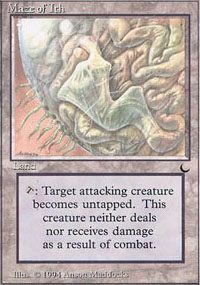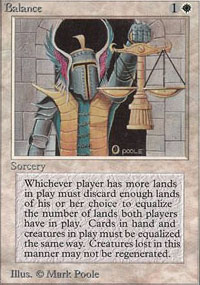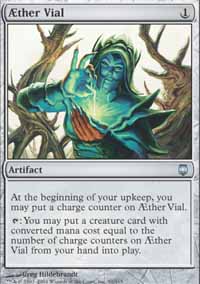
At some point during my childhood I learned something very important about baseball. You don't have to hit a home run every time you step up to the plate in Little League. You don't need to crank out that timely double down the third base line or rip a nasty single up the middle. To be a good hitter you just have to hit the ball hard. Nine-year-olds can't catch a hard grounder any more than a drive to the gap, so just don't strike out and you are an asset...in Little League. Magic used to be like that.

I actually would have beaten
Zak's deck handily under modern
rules. But my Maze of Ith was unable
to keep his Serra Angel from dealing
damage back then. Can you figure
out why?

I have mentioned this before, but
the experience was such an
important lesson for me that I am
saying it again. Adam owned me
hard with this card.
In my preparation for that first tournament, I had learned that lesson very well. I was playing RGB land destruction control. The design was straightforward enough; toss in just about every card capable of destroying a land and call it a deck. In my testing I quickly realized that moxen and Black Lotus were my greatest threats. I actually considered very bad cards like Artifact Blast just to fight this problem. It is an incredibly narrow card, but I really needed to stop those cheatin' artifacts from producing mana. That really weakened the deck to the point where I nearly dropped it the night before the tournament. In fact I got compliments from the guy who beat me. He hadn't believed that land destruction as a primary strategy could be done. He knew the same thing I discovered about artifact mana. Broken cards like that don't just warp the meta. They force out entire strategies.
OK, so on to the relevant part
That brings us to the current metagame in Legacy. A quick look at numbers makes it clear that Goblins is the number one deck with Threshold in a close second. They have been one and two for a year or so, now. And little about either has changed. And it doesn't take a genius to predict that these two will be the decks to beat in Columbus next May.
| GoblinsMagic OnlineOCTGN2ApprenticeBuy These Cards | ||
|---|---|---|
|
Artifacts 4 Aether Vial Creatures 4 Gempalm Incinerator 4 Goblin Lackey 4 Goblin Matron 4 Goblin Piledriver 4 Goblin Ringleader 4 Goblin Tinkerer 4 Goblin Warchief 4 Mogg Fanatic 2 Siege-gang Commander | Basic Lands 6 Mountain Lands 4 Bloodstained Mire 4 Rishadan Port 4 Wasteland 4 Wooded Foothills | Sideboard 3 Tormod's Crypt 4 Pyrostatic Pillar 3 Pyrokinesis 3 Chalice of the Void 2 Red Elemental Blast |
This is a fairly typical modern build of Goblins. It wins by (among other things) cheating creatures into play while accumulating card advantage with those same creatures and attacking in swarms. All purely aggressive decks are outclassed by Goblins. Consequently any would-be aggressive decks have to pack strong control elements to compete. Threshold is one such deck capable of handling a variety of opponents due to its decent offensive capabilities paired with simultaneous (thanks Bardo) ability to play defense. It is this niche that allows it to keep up with Goblins. And in Legacy, combo is severely hampered by the ability of Threshold to keep them on a short leash.
That leaves control. While some decks that pair board control with a smattering of hand and/or land destruction (think Dirt and Truffle Shuffle types) have shown some promise, they are simply not as reliable as the top two decks. This is partly because they have to delve into three colors to get access to enough good cards, and partly because the demands of Solidarity (the most successful combo deck of late) defense and Goblin defense are polar opposites without countermagic. Prison decks have largely failed to produce results despite a great deal of attention. And metagame-dependent, combo-fearing control decks such as Rifter and 43-Land are too narrow to be counted on. But even more than other control decks, it's the classic control strategies like Landstill and Monoblue Control which lean heavily on countermagic that have had the most problems very similar to my difficulties with moxen and Black Lotus back in early 1995.
I'm going to go out on a limb here
The problem is the Aether Vial in Goblins.
More than any other card, this one removed Landstill from its perch as the number one control deck of the format. Goblins existed as a deck long before the advent of the vial, but it was never good enough to outperform control. A resolved Vial spells near-certain doom if it hits on turn one against Threshold. That means on the draw that Threshold is either holding a Force of Will or it can expect to eventually lose. Because from then on the Vial's ability to render counterpells almost entirely irrelevant puts a stake in the heart of any deck hoping to beat Goblins with blue defense. And Threshold is a fast, dynamic deck with lots of access to dedicated goblin solutions. Goblins can kill on turn four in the absence of defense, but they will just as certainly kill you eventually if you are control facing down a Vial. That's right. Aether Vial actually makes this aggro deck stronger against control the longer the game goes on.

You Bastard!
It is Aether Vial which enables Goblins to selectively play the role of aggro or control as needed (not that it sacrifices anything aggressive to do this) with its ability to effortlessly afford the three or four mana necessary for an instant speed answer attached to a goblin. Sure it's the Matron and Ringleader that do the fetching, but would they be as good, or for that matter worth having in the deck at all without Aether Vial? This strategy put control out of business in Legacy until further notice, and it is what allows Goblins to keep all other aggro in a heap well behind it. Sure Pithing Needle will keep any number of vials out of business but at what cost to design space? It is not a particularly strong sideboard card in general. Yes, the needle has a variety of uses, but its prevalence has been waning. Currently the very best common use for it is probably Aether Vial. So, do you pack this card (or something similar like Disenchant) in your new fangled control deck knowing that you would prefer something more robust? If you do your deck is weakened, but if you don't the vial will get you. So it is the Artifact Blast dilemma all over again.

Not exactly top notch anti-mox
tech. I most certainly would
have played Chalice of the Void for
zero back then if I could have.
Another obfuscating factor is Threshold's presence. (Yeah, Gush in Threshold. That would be a fun for about a day.) Its tireless pursuit is also why Goblins does not appear to be controlling the metagame. As long as we continue to see a number two deck, number one tends to be safe from critical eyes. But what if number one has a single card that prevents whole sides of the game from seeing play? Just because one other strategy works, it does not mean that the format is healthy.
Now the doom and gloom
The deck is everywhere. The cards are relatively easy to acquire, and the gameplay is very intuitive so it can be picked up and learned quickly. It can even be played successfully without dual lands. And while Aether Vial can't take credit for all the abilities of the deck, it does squash entire strategies on its own such as mana denial, countermagic, card advantage - all classic control elements. And since Goblins is also faster and more consistent than any other aggressive deck out there, the deck keeps those out as well. So if you can't beat 'em, join 'em. And they do. Players flock to the deck, noob and veteran alike, just like tree sap or a festering pustule. That's because it has that same nullifying quality the Balance deck did more than a decade ago. This is the perfect environment for an infection like Aether Vial to flourish in. And it has cheated the game so far that the metagame has formed around it.
Of course the logical conclusion to this line of reasoning is that Threshold would therefor be the undisputed top deck. I would agree with this sentiment except that I strongly suspect it will not happen. As we approach Grand Prix Columbus, the format is already awash with would-be contenders that can't realistically beat Goblins but do very well against Threshold. Black, for example, has many excellent strategies that are hard on both Threshold and storm combo, but perfectly awful against Goblins - making them very hard to implement. Ban Aether Vial before May and we might get a surprise. Goblins will still be present, but without its unfair turbo booster. It's a big format after all. And there will always be a way if the playing field is level. The net result would simply be the allowance of many more decks to be competitive. And who wouldn't like more variety? Ban it as close to the event as possible and the place will be mobbed with players trying to muscle in on a format ready for a new hierarchy. That would be stupendous!
Wizards came out and said that Legacy would be getting a test drive for a little while to see if they would continue to support it. Well, last year we got two Grand Prix events. This year there is one on the docket. See where I'm going with this? If we have a predictable replay of last year how many new players can we possibly hope to attract for what follows? Legacy is supposed to be the format of deck tech opportunity. That has been its greatest feature. Right now it is not. Heed my advice and demand an important change of this sort so we get our greatest asset back. Do nothing and it could be the last Grand Prix we ever get. With no surprises. No drama. Just a format slowly dying from its own stagnation.
Comments